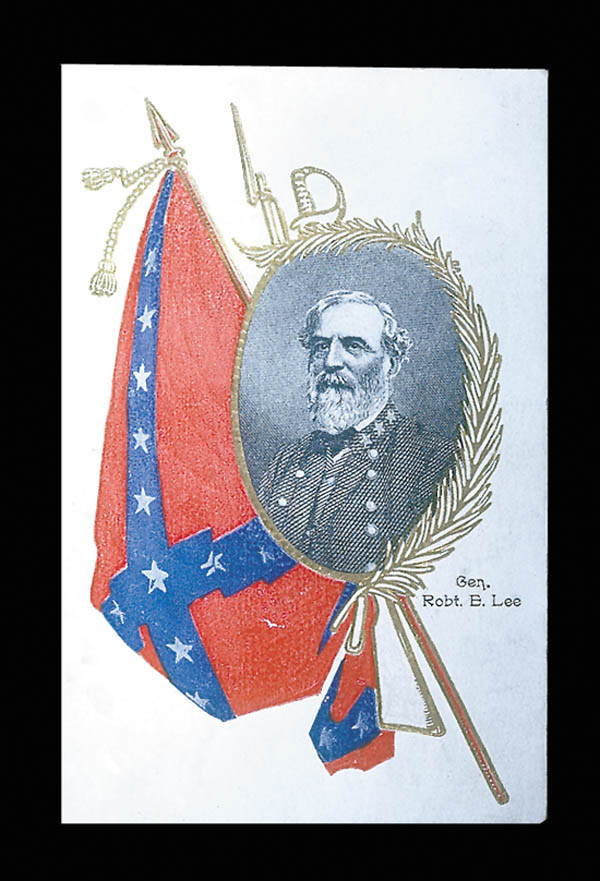The Rebel Battle Flag Of The Confederacy
Less than a month after convening and barely two weeks after inaugurating Jefferson Davis as president of their new nation, the Confederate Provisional Congress adopted an official flag, the famous "Stars and Bars." A special Committee on the Flag and Seal of the Confederacy, headed by William Miles of South Carolina, had previously been appointed and they came in with a design that had seven stars - one for each of the states then in secession - and three stripes. The emblem flew for the first time on March 4, 1861, its day of approval, over the capitol at Montgomery, host to the Congress. Miss L.C. Tyler, granddaughter of former United States President John Tyler did the honors.
Unfortunately, in July of that year, this flag proved unsuitable on the field of battle. At the first Battle of Manassas (called Bull Run by the North) in Virginia, the similarity between the Union and Confederate flags caused much confusion.
To remedy the problem, General Joseph E. Johnson, top Southern commander and victor at Manassas, asked his staff for suggestions about a new flag. Many ideas were presented over the next few days, including several by General Beauregard.
The model submitted by Beauregard for one of these was eventually accepted. It had a red field and a blue saltier with thirteen stars. Its design was claimed later by two men - the aforementioned William Miles, and Edward C. Hancock. Johnson approved it as the battle flag for his army. Later, in quick order, most other Southern military forces adopted it.
The flag with its blue cross of Saint Andrew received immediate public approval and Southerners everywhere took it to their hearts. Nearly every Reb soldier who wore the butternut uniform fought under it.
By the time that the Battle Flag came into use, in late 1861, four more states - Virginia, Arkansas, Tennessee and North Carolina - had joined the original seven in rebellion. These eleven states which had formally seceded, and splinter groups in Kentucky and Missouri which adopted ordinances of secession - though in those two states the official governments were in Union hands - made up the 13 states found on the new Battle Flag and all other varieties used during the next four years.
The new flag, with its blood red background, was proudly flown as the banner of the tattered and courageous Southern army in every battle fought. The sight of it is said to have lightened the step of many a Johnny Reb as he marched from battlefield to battlefield, often hungry and weary, but always with hope.
The Battle Flag came in several sizes, dependent upon where and how used. It was 52 inches square in size for the infantry, 38 inches for the artillery, and 32 inches for the cavalry. It also came in the traditional rectangular size for non-military purposes, close to the official 1:1.9 ratio of the "Stars and Stripes."
In 1863 the official flag of the Confederacy - the "Stars and Bars" - was changed. The new emblem incorporated the military's Battle Flag as its union (a square two-thirds the flag's width located in the upper left hand corner, as the 50 stars now do in the United States Flag) and everything else (the field) being white. This so-called "Stainless Banner" did not work out well in combat either because it looked too much like a symbol of surrender whenever the wind stopped blowing and it lay furled. Throughout the South, no new banner could ever take the place of the revered Battle Flag. Even the Confederate Navy used the rectangular style of the Battle Flag as its jack.
After Lee's surrender at Appomattox, and throughout the decade or so of Reconstruction and ever afterward, the inspiring Battle Flag of the Confederacy continued to wave. It became a symbol to all Southerners of a cherished way of life now lost.
It also became the banner of many die-hard Rebs who still believed in the Old South. The Sons of Confederate Veterans, a patriotic fraternal organization dedicated to the task of honoring the fallen soldiers and living veterans of the Southern cause, as well as perpetuating ante-bellum culture and philosophy, quickly adopted the Battle Flag as its official insignia.
Postcards Of The Rebel Battle Flag
Once called the "Southern Cross" by many, the Flag appeared on a number of Southern patriotic and Confederate Memorial Day postcards issued prior to World War I. Several sets by anonymous publishers, including one attributed to Souvenir Post Card Company and one with the so-called Lounsbury backs, featuring Confederate statesmen and military leaders abound with the colorful pennant. Raphael Tuck and Sons' great unnumbered "Memorial Day" set of twelve for sale below the Mason-Dixon Line gives the hallowed flag great prominence in many of the illustrations.
Some linen style postcards of the 1930s and 1940s and countless chromes of the last 50 years highlight the famous flag. On most it dominates or fills the entire card. The Civil War Centennial celebration of 1961-1965 was the catalyst for an outpouring of Confederate themes, including the flag of the Southern armies.
Today, nearly 150 years after the end of our country's most destructive war, the flag of the valiant South still waves in many states of the old Confederacy over government and private buildings alike. It has proved extremely helpful in promoting tourism for the region. But it is also a major bone of contention within states like South Carolina where the NAACP is committed to its removal in the belief that the Rebel Battle Flag still promotes racism.
The Battle Flag of Johnny Reb is easily the second most recognized flag - after "Old Glory" - in the nation. This popularity is reflected by its continued use on postcards.













